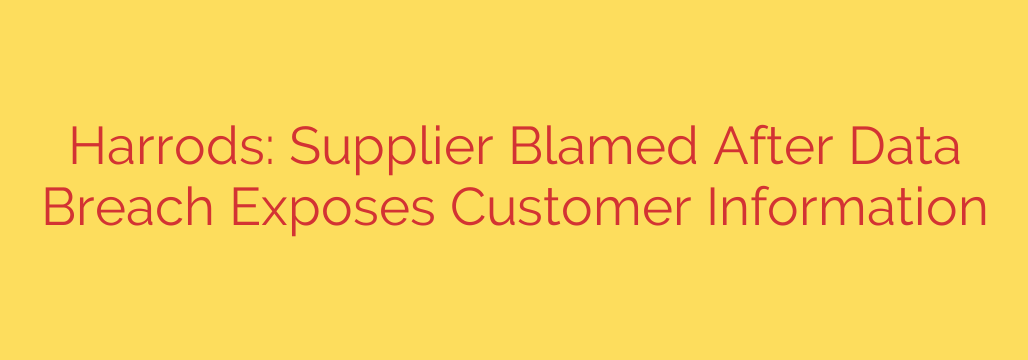
Harrods Data Breach: What Customers Need to Know to Stay Safe
News of a data breach at a renowned institution like Harrods can be unsettling for any customer. A recent security incident has brought the issue of data protection to the forefront, highlighting how even the most established brands can be affected. The breach stemmed not from a direct attack on Harrods’ systems, but from a vulnerability within a third-party supplier, a marketing services company named Epsilon.
Here’s a clear breakdown of what happened, what data was involved, and the essential steps you should take to protect yourself.
The Root of the Breach: A Third-Party Supplier
In this incident, the security weakness was traced back to Epsilon, a company Harrods used for marketing communications. This type of event is known as a supply-chain attack, where criminals target a smaller, connected company to gain access to the data of a larger organization.
This method is increasingly common, as major corporations often have robust security measures that are difficult to penetrate directly. By targeting vendors, attackers find a softer entry point. Harrods has since confirmed the incident and has been communicating with affected customers to provide guidance and reassurance.
What Information Was Exposed?
It is crucial to understand exactly what data was and was not compromised. According to the information released, the exposed data was limited.
- Data Exposed: The breach included customer names and email addresses.
- Data NOT Exposed: Critically, no financial information, such as credit or debit card details, was compromised. Furthermore, account passwords and home addresses were not part of the data set held by the supplier.
While the absence of financial data is a relief, the exposure of names and email addresses still presents a significant security risk that every customer should be aware of.
The Primary Risk: Targeted Phishing Scams
The main danger following this type of data breach is an increase in targeted phishing attacks. With your name and email address, cybercriminals can craft highly convincing and personalized scam emails.
These fraudulent emails might:
- Appear to be from Harrods or another trusted company.
- Address you by your full name to seem more legitimate.
- Claim there is a problem with your account or an order.
- Ask you to click a link to “verify your details” or “update your password.”
The goal of these emails is to trick you into visiting a fake website and entering sensitive information like your password, address, or financial details. This is how criminals turn a minor breach into a major security event for an individual.
Actionable Steps to Protect Your Information
Vigilance is your best defense. Even if you haven’t received a notification, practicing good digital hygiene is essential. Follow these security tips to safeguard your accounts and personal data.
Be Skeptical of All Unsolicited Emails: Treat any unexpected email claiming to be from Harrods with caution. Scrutinize the message for unusual phrasing, grammatical errors, or an urgent tone designed to make you act without thinking.
Verify the Sender’s Email Address: Before clicking anything, carefully examine the sender’s email address. Scammers often use addresses that are slightly different from the official one (e.g., “Harrods-Support” instead of “[email protected]”).
Never Click Suspicious Links: Hover your mouse over any links in an email before clicking to see the destination URL. If it looks unfamiliar or doesn’t match the official Harrods website, do not click it. It’s safer to manually type the website address into your browser.
Do Not Share Personal Information: Harrods and other legitimate companies will never ask you to provide your password, full credit card number, or other sensitive data via email. Any message requesting this information is a scam.
Use a Strong and Unique Password: Ensure your Harrods account password is not used for any other online service. If you use the same password across multiple sites, a breach at one company can put all your accounts at risk. Consider using a password manager to create and store complex, unique passwords for each of your accounts.
By staying informed and taking these proactive steps, you can significantly reduce your risk of falling victim to fraud in the wake of this or any other data breach.
Source: https://go.theregister.com/feed/www.theregister.com/2025/09/29/harrods_blames_thirdparty_supplier_after/








